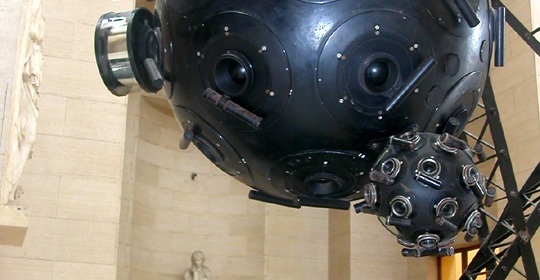Zeiss II
The old Zeiss II projection instrument displayed at the entrance of the New Planetarium of Rome.
It is an optical projector, made by the Zeiss company of Jena model II. It is 2 metres high and about 1.2 metres wide. It consists of two spheres joined by a circular frame. The spheres are perforated and have about 5000 stethoscopic holes representing as many stars, including the Milky Way and some nebulae, while about 150 brighter stars have individual lenses.

Between the two mentioned projection hemispheres, several projectors represent the equator, the ecliptic and the 12 zodiacal constellations. The two hemispheres together are moved by a three-axis system, which makes it possible to create, among other things, a rotational movement around a conventionally calculated axis, to simulate the Earth's precession motions or the view from a particular satellite or another planet.
Around the hemispheres, there is a structure in the shape of an arc of a circle, on which are arranged eight individual projector systems for the Sun, the Moon and 6 planets. Each individual projector is equipped with two optical systems, which make it possible to show both a bright spot, the planet as seen with the naked eye, and a magnified image as if observed with a telescope. The eighth projector has an image of the Earth and a small marker, designed to show this or that celestial entity more precisely or even to make outlines such as circles, ellipses, rings, retrograde motions of the planets, contour lines of constellations, etc.
The instrument, original in every part, was donated by Germany to Italy after the end of the First World War as partial reparation for war damage and was installed in the Sala della Minerva in the Terme di Diocleziano and inaugurated on 28 October 1928 at the presence of Mussolini.
In 1980, the Soprintendenza Statale decided to restore the Sala della Minerva and use it as an exhibition hall. After a troubled history, the Planetarium was dismantled, packed up, handed over to La Sapienza University and deposited at the Osservatorio di Monteporzio. In 2000, La Sapienza University gave the crates containing the ancient instrument to the City of Rome, which had them reassembled so that the public could admire them at the entrance to the new Planetarium.
Of all the Zeiss II models that had been installed in Planetariums all over the world, this one in Rome is the only one to have survived.
This instrument has an illustrious history and deserves a special mention. It is in fact unique in the world: apart from the prototype (Mark I, which only reproduced the northern hemisphere of the sky), this is the only and oldest Zeiss Mark II planetarium still in existence, in its complete structure. The first planetaria were installed in Germany from 1926 onwards, but many of them were destroyed in the bombings of World War II. Its value is inestimable, as it represents a true jewel of technological and industrial archaeology, which has very few analogues in terms of uniqueness among human artefacts: the original daguerreotype, the first pascaline, the Wright brothers' aeroplane, Sputnik or even Galileo's telescope, to name but a few famous comparisons. The old Zeiss projector in the Planetarium of Rome will be the centre of attention of the world planetarium community on the occasion of the centenary of the invention of this extraordinary instrument for projecting the sky, in 2023.





































